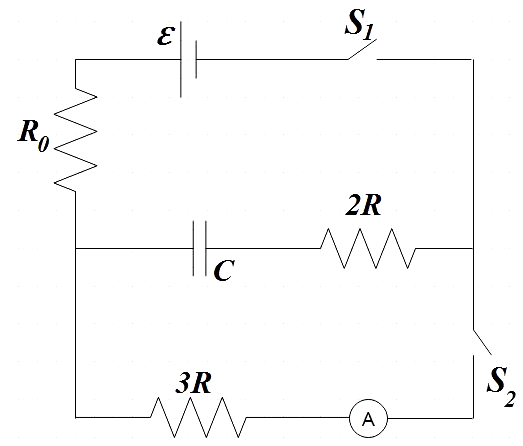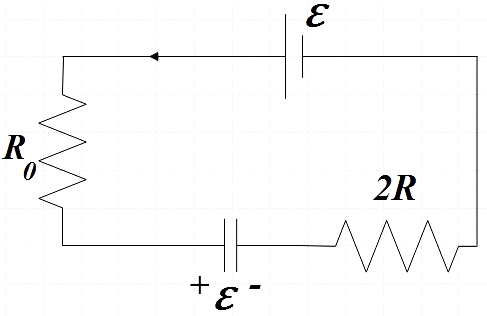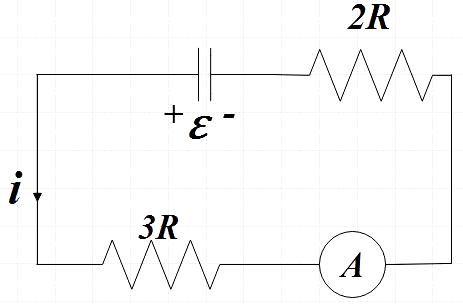Question
Question: Switch \({{S}_{1}}\) is closed for a long time while \({{S}_{2}}\) remains open. Now at t=0, \({{S}_...
Switch S1 is closed for a long time while S2 remains open. Now at t=0, S2 is closed while S1 is opened. All the batteries are ideal and connecting wires are resistance-less. The capacitor C is initially uncharged.

A. At time t=0, reading of ammeter is 5Rε
B. At time t=0, reading of ammeter is zero.
C. Heat developed till time t=RCln2 in resistance 3R is 409Cε2
D. After time t > 0 charge on the capacitor follows the equation Cεe5RCt
Solution
When S1 closed with S2 open, the capacitor develops a potential difference of ε and when the S2 closed with S1 open at t =0, then the capacitor starts discharging. You could find the effective resistance in the circuit and then apply ohm’s law to find the current. Then recall the expression for charge stored in a capacitor at time t and do necessary substitutions to get the charge in the given capacitor at t>0. Using the above charge, find the energy stored at a given time t and then find the difference in energy stored from t=0 to t=t to find the heat developed. And then find heat developed by resistance 3R.
Formula used:
Ohm’s law,
V=IR
Charge at time t,
q=q0e−τt
Energy stored in a capacitor,
E=21CV2
Complete step-by-step answer:
When switch S1 is closed with S2 open, after a longtime, the capacitor in circuit gets fully charged with potential difference equal to that in the cell.

Now when the switch S1 is kept open with S2 turned on at t = 0, the capacitor starts discharging.

The charge in the capacitor at t =0 will be,
Q=Cε …………………………….. (1)
From ohm’s law we know that,
I=RV
Where R is the effective resistance of the given circuit,
R=2R+3R=5R ……………………………… (2)
⇒i=5RE …………………………... (3)
Therefore option A is true.
We know that charge stored in a discharging capacitor at a time t is given by,
q=q0e−τt
Where, τ=RC
For the given circuit, charge in the capacitor at t using (1) and (2) is given by,
q=(Cε)e5RC−t …………………………… (4)
Therefore option D is true.
When, t=5RCln2
q=Cεe5RC−5RCln2
⇒q=Cεe−ln2=Cεeln(2−1)
But we know, elnx=x
So, charge stored in the capacitor at time t=5RCln2 is given by,
q=2Cε
Energy stored by the capacitor at t =0 is,
Ei=21Cε2
Charged stored by capacitor at t=5RCln2 will be,
Ef=21Cq2
⇒Ef=21C(21Cε)2=81Cε2
The change energy from t =0 to t=5RCln2 gives the heat total developed during that interval,
ΔE=Ei−Ef=81Cε2−21Cε2=83Cε2
Heat developed across just the 3R resistor is given by,
H3R=83Cε2×53
⇒H3R=409Cε2
Therefore option C is also true.
Hence, we see that options A, C and D are true for a given situation.
So, the correct answers are “Option A, C and D”.
Note: In questions like this where we have to find the true statements among the given ones, we should check all the options one by one and then declare the correct answer. Chances are there for multiple options being true. So even when you find the very first option as true, you must check for the true statement in the other options too.
